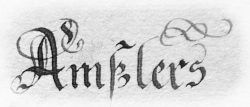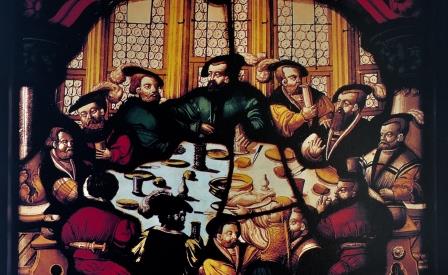Over the years, the venerable “Kilchhöri” or parish of Elfingen evolved into the present-day parish of Bözen. Understanding this historical development is important in early genealogical research in the communities concerned.
The early history of the parish
The history of the parish of Bözen goes back very far. The Alsatian monastery of Murbach was founded in the 8th century. The monastery owned, among other property, the Dinghof Elfingen. Its ecclesiastical center was originally in Elfingen. The church there was dedicated to St. Leodegar and was built around 950 AD. Presumably a Verena chapel already existed there earlier.
There is also evidence of a Maria chapel in Bözen from this time. In 1381 this chapel was elevated in status as a branch church of Elfingen. The parish priest lived in Elfingen and not only looked after the three villages of Elfingen, Bözen and Effingen, but also Linn and Zeihen.
In 1514 the territory of Bözen, Effingen and Elfingen was purchased by Bern. With the introduction of the Reformation in the federal city-state of Bern in 1528, these communities also changed to the new faith.
The village of Zeihen remained part of the Habsburg Fricktal and thus Catholic. In return, the Bernese were awarded Densbüren and the associated hamlet of Asp. This village also changed its faith and became part of the parish of Elfingen for the time being. The village of Linn, which had already belonged to the Bernese territory before 1528, also remained part of this parish.
The village of Densbüren-Asp was separated from the parish of Elfingen in 1642 and became ecclesiastically independent. Linn was assigned to the parish of Bözberg in 1649.
From now on the parish consisted of the three villages Bözen, Effingen and Elfingen.
The church center moves to Bözen
As early as 1534, the Bernese rulers decided that only one place of worship should exist. The population decided in favor of Bözen. The church of Elfingen was abandoned and slowly decayed. It is assumed that it was demolished between 1562 and 1577.
On the other hand, the chapel in Bözen had become too small and was replaced by a newly built church in 1667. However, the pastor continued to live in Elfingen for about 300 years.

The red markings on the above map correspond approximately to the present municipal boundaries of the three villages. Note the correspondence with the boundary of the Murbach owned Dinghof Elfingen in the 12th century.
Church registers
With the beginning of the keeping of church records under Bernese rule, one gains insights into the local population. A few decades after the reformation had spread, the local priests were ordered to register the citizens in their parish. These records, known as “Kirchenbuecher” or church records, are among the earliest and best sources of information for genealogists. Before that time there was hardly any trace of the lives of common people unless they owned substantial property, for example a flour mill, held an office or committed a crime.
Initially the church records were limited to recording the dates when children were baptized, the names of the parents and often the names of the witnesses. Later marriages and death records were added and as time went by, they become more detailed. Registers might contain information about occupations and trades or if a spouse was from out of town. All this data allows the establishment of family trees based on paper trails. Many of these records still preserved today were started in the second half of the 16th century, a few decades after the reformation was introduced. Most of the information regarding the Amsler families is based on these church records although occasionally other sources provide insight in the lives of our ancestors.
The church registers thus contain entries for all of the above-mentioned localities, sometimes even indicating the respective place of residence of the parents or the spouse. The books are in the archives of the municipality of Bözen. Copies on microfilm are in the State Archive in Aarau.
The first church register from 1562 until 1604
This narrow, fragile book contains 122 pages of handmade paper. It is 460 years old, the writing is partly faded and often barely legible. In the directory “Kirchen- und Jahrzeitbücher des Kantons Aargau 1200-1900” of the Aargau State Archive it is listed under the title „KI/01 – Bözen 01 – 1562-1604“. The contents are baptisms and marriages for Bözen, Elfingen, Effingen, Linn, Densbüren and Asp.
On the first page there is an entry by Ulrich Kienberger, the pastor of the parish. In 1562 he still refers to both churches, the one in Bözen and the one in Elfingen.
The church register or baptismal book contains the children baptized by him starting from May 31, 1562.

Rodel der getauften Kinder der
Kilchenn zu Elfingen und
Bözenn angfangenn durch
mich Ulrichenn Kienberger da…
predicant daselbst
1562 den
31 Mey
The second church register from 1604 until 1685
Similar in format to its predecessor from 1562, it is somewhat better preserved and contains 237 pages. On the first page there is an entry by Cunrat Wyss, the pastor of the “church in Bözen” at that time. It is a list of the children baptized by him starting from the year 1604. Marriages were also recorded.

Verzeichniss der Christ
kindern, so von mir Cunrat
Wyss predicanten zu
Elfingen, in der kilchen Bö
zen getauft worden sind;
von Ad 1604
This church register contains baptisms and marriages for the municipalities Bözen, Elfingen, Effingen and the hamlet Käsenthal. For a short period it also included those for Linn, Densbüren and Asp. It is listed under the title „KI/02 – Bözen 02 – 1604-1685“.
By 1604 the sole church is located in Bözen. From now on, the parish is referred to as the „Bözen parish“.
Difficulties in creating family trees
As for Bözen, the author of this post has visited the village archive many times and has recently photographed every page of the older registers in order to transcribe them at home. With this data and paper trails one can establish a family tree for almost any citizen with the hometown being Bözen. After around 1750, family registers were kept which make it easier to track individual families.
Before that time it is considerably more difficult. The local priest simply kept sequential records of births, marriages and deaths. In the birth records you would find the names of the parents and witnesses. In the death registers you might get an indication of age of the deceased, but that is spotty. Using this information one can piece together a family tree.
In these records we encounter much diversity, from clean and meticulous handwritings to almost unreadable, all depending on the individual in charge at the time. So it takes quite a bit of expertise to decipher the scripture of various authors’ records over the centuries.
Also, often multiple families with the same family name would exist at any given time combined with a somewhat limited selection of first names. This makes it extremely difficult to be certain of generation and family linkages. I often find diverging information and mismatches in what appears to be well researched family trees.





2 thoughts on “The Bözen Parish”
Great website! My Grandfather, Paul Trinkler was born and raised in Bözen. He immigrated to Canada in the 1920’s. I don’t know if you have seen it, but there is an aerial photograph of Bözen from 1923. If you want a copy, please let me know! Thank you!
Thank you for your comment, I do have a Paul Trinkler in my records, born in 1907. The Trinkler family in Bözen goes back to the very beginning of record keeping around 1562!
I may have seen the aerial photograph, is it the one taken by Walter Mittelholzer?